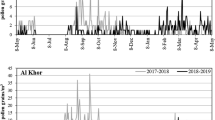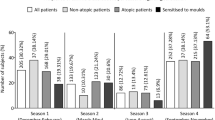Abstract
Atopic dermatitis (AD) is a highly prevalent and multifactorial condition influenced by environmental factors such as the concentration of airborne allergens and meteorological variables. However, there is a lack of consensus on the role of these factors in triggering AD, particularly in tropical areas, where high values of these variables are common and studies are scarce. Therefore, this ecological study aimed to assess the association between concentrations of outdoor fungal spores and tree pollen, temperature, and water vapor pressure with AD-related medical services utilization in children 12 years or younger residing in a tropical urban area (San Juan, Puerto Rico), from 2017 to 2020. The study analyzed medical records of two dermatology clinics and local data on outdoor aeroallergens and meteorological variables to determine the number of AD-related medical claims during the study period, based on their medical diagnostic code. The multivariate regression analysis showed that high tree pollen concentrations (IRR = 1.2670, p = 0.032) and low average temperatures (IRR = 1.3114, p = 0.009) increased the probability of AD-related medical claims. In contrast, this probability was reduced with high average temperatures (IRR = 0.6782, p = 0.001) and low water vapor pressure values (IRR = 0.7802, p = 0.022). No associations were found with outdoor fungal spores. In conclusion, this study found that high tree pollen concentrations and low temperatures increased the utilization of AD-related medical services. Educating individuals about reducing exposure to unfavorable environmental conditions could be a useful intervention in preventing the exacerbation of AD.


Similar content being viewed by others
References
Ahn, K. (2014). The role of air pollutants in atopic dermatitis. The Journal of Allergy and Clinical Immunology, 134(5), 993–999. https://doi.org/10.1016/J.JACI.2014.09.023
American Academy of Allergy, Asthma, and Immunology. (2020). Skin allergy overview. AAAAI. https://www.aaaai.org/conditions-and-treatments/allergies/skin-allergy
American Academy of Allergy, Asthma, and Immunology. (n.d.). AAAAI. https://pollen.aaaai.org/#/
Boguniewicz, M., Fonacier, L., Guttman-Yassky, E., Ong, P. Y., Silverberg, J., & Farrar, J. R. (2018). Atopic dermatitis yardstick: Practical recommendations for an evolving therapeutic landscape. Annals of Allergy, Asthma & Immunology, 120(1), 10-22.e2. https://doi.org/10.1016/J.ANAI.2017.10.039
Bonamonte, D., Filoni, A., Vestita, M., Romita, P., Foti, C., & Angelini, G. (2019). The Role of the environmental risk factors in the pathogenesis and clinical outcome of atopic dermatitis. BioMed research international. https://doi.org/10.1155/2019/2450605
Bosma, A. L. A., Ouwerkerk, W., & Middelkamp-Hup, M. A. (2021). Children with atopic eczema experiencing increased disease severity in the pollen season more often have hay fever at a young age and a dark skin type. Journal of Dermatology, 48(4), 470–475. https://doi.org/10.1111/1346-8138.15750
Caraballo, L., Zakzuk, J., Lee, B. W., Acevedo, N., Soh, J. Y., Sánchez-Borges, M., Hossny, E., García, E., Rosario, N., Ansotegui, I., Puerta, L., Sánchez, J., & Cardona, V. (2016). Particularities of allergy in the Tropics. The World Allergy Organization Journal. https://doi.org/10.1186/S40413-016-0110-7
Covert, H. H., Soares, L. F., Wahid, F. A., Allen, T., Guido, Z., Johnson, D., Mahon, R., Méndez-Lázaro, P., Sherman, M., Ville, S., Trotman, A., & Lichtveld, M. Y. (2022). Priorities for bolstering public health resilience in the context of climate change in dominica and Puerto Rico. Annals of Global Health. https://doi.org/10.5334/AOGH.3876
Crameri, R., Garbani, M., Rhyner, C., & Huitema, C. (2014). Fungi: The neglected allergenic sources. Allergy, 69(2), 176–185. https://doi.org/10.1111/all.12325
Cuellar, P. F. (2022). Dermatitis Atópica altamente prevalente en Puerto Rico: un 10 a 12 % de la población lo padece. Medicina y Salud Publica. https://medicinaysaludpublica.com/noticias/dermatologia/dermatitis-atopica-altamente-prevalente-en-puerto-rico-un-10-a-12--de-la-poblacion-lo-padece/15644
Dohyeong, K., Seo, S. C., Min, S., Simoni, Z., Kim, S., & Kim, M. (2018). A closer look at the bivariate association between ambient air pollution and allergic diseases: the role of spatial analysis. International Journal of Environmental Research and Public Health, 15(8), 1–14. https://doi.org/10.3390/ijerph15081625
Drucker, A. M., Wang, A. R., Li, W.Q., Stevenson, E., Block, J. K., & Qureshi, A. A. (2017). The burden of atopic dermatitis: Summary of a report for the national eczema association. Journal of Investigative Dermatology, 137(1), 26–30. https://doi.org/10.1016/j.jid.2016.07.012
Díaz Rodríguez, A., Fabré Ortiz, D. E., Coutin, G., Iii, M., González, T., & Iv, M. (2010). La sensibilización a hongos ambientales y su relación con enfermedades atópicas en escolares The sensitivity to environmental fungus and its relation to atopic diseases present in school children. Revista Cubana de Medicina General Integral, 26(4), 647–655. http://scielo.sld.cu
Eichenfield, L. F., Tom, W. L., Chamlin, S. L., Feldman, S. R., Hanifin, J. M., Simpson, E. L., Berger, T. G., Bergman, J. N., Cohen, D. E., Cooper, K. D., Cordoro, K. M., Davis, D. M., Krol, A., Margolis, D. J., Paller, A. S., Schwarzenberger, K., Silverman, R. A., Williams, H. C., Elmets, C. A., … Sidbury, R. (2014). Guidelines of care for the management of atopic dermatitis. Journal of the American Academy of Dermatology, 70(2), 338–351. https://doi.org/10.1016/j.jaad.2013.10.010
Huang, A., Cho, C., Leung, D. Y. M., & Brar, K. (2017). Atopic dermatitis: early treatment in children. Current Treatment Options in Allergy, 4(3), 355. https://doi.org/10.1007/S40521-017-0140-6
Huang, Evie, & Ong, Peck Y. (2018). Severe atopic dermatitis in children. Current Allergy and Asthma Reports. https://doi.org/10.1007/s11882-018-0788-4
Jaume, M. E., & Guerra Pérez, T. (2019). Dermatitis atópica. 2, 161–175. www.aeped.es/protocolos/
Kallawicha, K., Chuang, Y. C., Lung, S. C. C., Han, B. C., Ting, Y. F., & Chao, H. J. (2016). Exposure to ambient bioaerosols is associated with allergic skin diseases in Greater Taipei residents. Environmental Pollution, 216, 845–850. https://doi.org/10.1016/j.envpol.2016.06.057
Kantor, R., & Silverberg, J. I. (2017). Environmental risk factors and their role in the management of atopic dermatitis. Expert Review of Clinical Immunology, 13(1), 15. https://doi.org/10.1080/1744666X.2016.1212660
Kim, H., Park, Y., Park, K., & Yoo, B. (2016). Association between pollen risk indexes, air pollutants, and allergic diseases in Korea. Osong Public Health and Research Perspectives, 7(3), 172–179. https://doi.org/10.1016/j.phrp.2016.04.003
Lewis, L. M., Mirabelli, M. C., Beavers, S. F., Kennedy, C. M., Shriber, J., Stearns, D., Morales González, J. J., Soto Santiago, M., Montalvo Félix, I., Ruiz-Serrano, K., Dirlikov, E., Lozier, M. J., Kanta Sircar, W., Flanders, D., Rivera-García, B., Irizarry-Ramos, J., & Bolaños-Rosero, B. (2019). Characterizing environmental asthma triggers and healthcare use patterns in Puerto Rico. Journal of Asthma, 57(8), 886–897. https://doi.org/10.1080/02770903.2019.1612907
Li, Q., Yang, Y., Chen, R., Kan, H., Song, W., Tan, J., Xu, F., & Xu, J. (2016). Ambient air pollution, meteorological factors and outpatient visits for eczema in Shanghai, China: A time-series analysis. International Journal of Environmental Research and Public Health, 13(11), 1106. https://doi.org/10.3390/ijerph13111106
Maymí, M. A., Somolinos, A. L., Nazario, C. M., & Sánchez, J. L. (2007). The prevalence of atopic dermatitis in Puerto Rican school children. Puerto Rico Health Sciences Journal, 26(2), 127–133.
Montealegre, F., Meyer, B., Chardon, D., Vargas, W., Zavala, D., Hart, B., & Bayona, M. (2004). Comparative prevalence of sensitization to common animal, plant and mould allergens in subjects with asthma, or atopic dermatitis and/or allergic rhinitis living in a tropical environment. Clinical and Experimental Allergy, 34(1), 51–58. https://doi.org/10.1111/J.1365-2222.2004.01855.X
Montealegre, F., Villa, J., Vargas, W., Hart, B., & Bayona, M. (2007). Risk factors for atopic dermatitis in southern Puerto Rico. Puerto Rico Health Sciences Journal, 26(2), 109–118.
Motomura, C., Hwang, Y., Fukuda, H., Kishikawa, R., Watanabe, N., & Yoshihara, S. (2022). Relationship among airborne pollen, sensitization, and pollen food allergy syndrome in Asian allergic children. PeerJ. https://doi.org/10.7717/peerj.14243
Méndez-Lázaro, P. A., Bernhardt, Y. M., Calo, W. A., Pacheco Díaz, A. M., García-Camacho, S. I., Rivera-Lugo, M., Acosta-Pérez, E., Pérez, N., & Ortiz-Martínez, A. P. (2021). Environmental stressors suffered by women with gynecological cancers in the aftermath of Hurricanes Irma and María in Puerto Rico. International Journal of Environmental Research and Public Health, 18(21), 11183. https://doi.org/10.3390/ijerph182111183
Nasarre, I. Q. (2009). Dermatitis atópica. Revista Pediatría de Atención Primaria, 11, 317–329.
National Aeronautics and Space Administration (NASA). (n.d.). Single Pixel Extraction Tool | Daymet. Retrieved Mar 5, 2023, from https://daymet.ornl.gov/single-pixel/
National Institute of Arthritis and Musculoskeletal and Skin Diseases. (2022). Atopic Dermatitis Treatment, Symptoms & Causes. NIAMS. National Institutes of Health. https://www.niams.nih.gov/health-topics/atopic-dermatitis
National Oceanic and Atmospheric Administration (NOAA). (n.d.). Climate. Retrieved Mar 5, 2023, from https://www.weather.gov/wrh/Climate?wfo=sju
Oh, S. J., Yoon, D., Park, J. H., & Lee, J. H. (2021). Effects of particulate matter on healthy skin: A comparative study between high- and low-particulate matter periods. Annals of Dermatology, 33(3), 263–270. https://doi.org/10.5021/AD.2021.33.3.263
Ong, P. Y., & Leung, D. Y. M. (2016). Bacterial and viral infections in atopic dermatitis: A comprehensive review. Clinical Reviews in Allergy & Immunology, 51(3), 329–337. https://doi.org/10.1007/S12016-016-8548-5
Quintero, E., Rivera-Mariani, F., & Bolaños-Rosero, B. (2010). Analysis of environmental factors and their effects on fungal spores in the atmosphere of a tropical urban area (San Juan, Puerto Rico). Aerobiologia, 26(2), 113–124. https://doi.org/10.1007/s10453-009-9148-0
Rivera-Mariani, F. E., & Bolaños-Rosero, B. (2012). Allergenicity of airborne basidiospores and ascospores: Need for further studies. Aerobiologia, 28(2), 83–97. https://doi.org/10.1007/s10453-011-9234-y
Rivera-Mariani, F. E., Almaguer, M., María, Aira, J., & Bolaños-Rosero, B. (2020). Comparison of atmospheric fungal spore concentrations between two main cities in the caribbean basin. In PRHSJ (Vol. 39, Issue 3). www.insmet.cu/asp/genesis.asp?TBO=
Roblin, D. W., Jones, J. W., & Fuller, C. H. (2021). Pollen exposure and associated healthcare utilization: A population-based study using health maintenance organization data in the Washington, DC, Area. Annals of the American Thoracic Society, 18(10), 1642–1649. https://doi.org/10.1513/AnnalsATS.202008-976OC
Schachtel, A., Dyer, J. A., & Boos, M. D. (2021). Climate change and pediatric skin health. International Journal of Women’s Dermatology, 7(1), 85–90. https://doi.org/10.1016/J.IJWD.2020.07.006
Stefanovic, N., Flohr, C., & Irvine, A. D. (2020). The exposome in atopic dermatitis. Allergy, 75(1), 63–74. https://doi.org/10.1111/ALL.13946
Sánchez, J., Sánchez, A., & Cardona, R. (2018). Revisión crítica de los resultados del ISAAC para dermatitis atópica en ciudades del trópico. Revista Alergia México, 65(4), 389–399. https://doi.org/10.29262/ram.v65i4.341
Villanueva, M. (2018, February). Dermatitis atópica. Gallenus. http://www.galenusrevista.com/?Dermatitis-atopica
Acknowledgements
We thank María López, MD, Director of External Clinics of the Medical Sciences Campus of the University of Puerto Rico, for contributing part of the data and to Maite Ramirez, Ph.D., Denise De Vore, Ph.D., and Osmarie Martinez, Ph.D., for their help in editing the manuscript.
Funding
No funding was received for conducting this study.
Author information
Authors and Affiliations
Contributions
EMV conceived the original research idea. EMV, IMR, CAA, PML, and BBR contributed to the study design and implementation. EMV and CAA conducted the statistical analysis. BBR, Director of the San Juan AAAAI-NAB, determined aeroallergen concentrations and provided the data. LTB, Director of Derma Salud Clinic, provided access to medical records in that clinic. EMV wrote the first draft of the manuscript. All authors commented on previous versions of the manuscript. All authors read and approved the final version of the manuscript.
Corresponding author
Ethics declarations
Conflict of interest
The authors declare that they have no known conflict of interests or personal relationships that could have appeared to influence the work reported in this paper.
Rights and permissions
Springer Nature or its licensor (e.g. a society or other partner) holds exclusive rights to this article under a publishing agreement with the author(s) or other rightsholder(s); author self-archiving of the accepted manuscript version of this article is solely governed by the terms of such publishing agreement and applicable law.
About this article
Cite this article
Miranda-Valentin, E., Mansilla-Rivera, I., Amaya-Ardila, C.P. et al. High tree pollen levels and low temperatures increased the utilization of atopic dermatitis-related medical services in children residing in a tropical urban area (San Juan, Puerto Rico). Aerobiologia (2024). https://doi.org/10.1007/s10453-024-09827-9
Received:
Accepted:
Published:
DOI: https://doi.org/10.1007/s10453-024-09827-9




